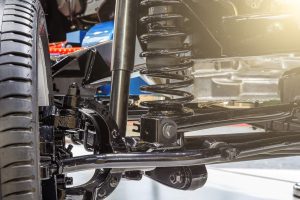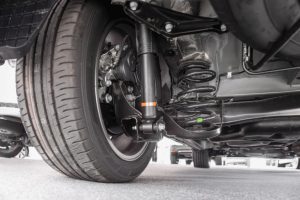Upgrading your car with aftermarket wheels and tires can dramatically change how it looks — and feels. While visual appeal is often the main driver, these modifications can significantly influence suspension performance and vehicle dynamics. In this article, we’ll explore how wheel and tire choices affect ride comfort, handling, and suspension stress — and how to make smart upgrades without compromising performance.
How Wheels and Tires Affect Suspension Dynamics
Aftermarket wheels and tires can alter the following suspension-related forces:
-
Unsprung Mass: Heavier wheels and tires increase the mass that suspension must control, leading to slower response and reduced grip.
-
Tire Profile: Lower-profile tires offer sharper handling but transmit more road harshness.
-
Wheel Offset and Backspacing: Changes in offset alter scrub radius and steering feel.
-
Tire Width: Wider tires increase lateral grip but affect steering responsiveness and ride smoothness.
Effects at a Glance:
| Upgrade Component | Impact |
|---|---|
| Heavier wheels | Reduced responsiveness, increased wear on dampers |
| Larger diameters | Changes ride height, alters suspension geometry |
| Lower-profile tires | Sharper steering, stiffer ride |
| Wider tires | Improved traction, potential for scrub radius issues |
| Different offset | May introduce torque steer or alignment issues |
Unsprung Mass: The Hidden Suspension Strain
Unsprung mass refers to components not supported by the car’s suspension — such as wheels, tires, brake calipers, and part of the control arms. Heavier unsprung mass:
-
Reduces suspension ability to keep the tire planted
-
Slows rebound movement
-
Increases shock absorber wear
Upgrading to lightweight alloys or forged wheels can reduce unsprung mass and improve suspension responsiveness.
Tire Profile and Sidewall Flex
Low-profile tires (e.g., 35-series) reduce sidewall flex for sharper cornering but:
-
Transmit more road imperfections
-
Increase suspension feedback to the chassis
-
Can cause faster shock wear and harsher ride
Conversely, taller sidewalls offer more absorption and isolation at the cost of handling precision.
Wheel Width, Offset & Scrub Radius
Changing wheel width and offset affects scrub radius — the lateral distance between steering pivot and tire contact center.
-
Positive scrub radius = increased steering torque, potential torque steer
-
Negative scrub radius = reduced stability under braking
Misaligned offset can:
-
Alter camber under load
-
Affect camber gain and jack under braking
-
Disrupt handling balance
Effects on Ride, Handling, and Braking
Cornering & Steering
-
Wider tires increase lateral grip but may make steering heavier or slower.
-
Larger wheels with low profile tires sharpen response but expose suspension to more shock.
Ride Quality
-
Heavier and stiffer wheel/tire combos transmit more bumps.
-
Oversized wheels may reduce travel, causing contact between suspension components and body.
Braking Performance
-
Increased rotational inertia from heavy wheels reduces braking efficiency.
-
Tire compound significantly affects wet/dry grip and ABS response.
Choosing Combinations that Work with Suspension
To maintain balance when upgrading, follow these guidelines:
-
Keep wheel diameter within one size of factory spec to preserve suspension geometry.
-
Opt for lightweight wheel materials to minimize unsprung mass.
-
Match offset to maintain scrub radius close to OE spec.
-
Avoid extremely low profile tires unless suspension geometry and shim stack allow for it.
-
Use wider tires only if steering arm and roll center allow proper clearance.
| Upgrade Goal | Recommended Approach |
|---|---|
| Better handling | Stiffer tires + lightweight wheels |
| Improved ride quality | Maintain moderate aspect ratio + spring tuning |
| More grip for track use | Wider rubber + correct offset alignment |
| Lower unsprung mass | Choose forged or lightweight alloy wheels |
When Suspension Upgrades May Be Needed
If your wheel/tire upgrades exceed factory tolerances, consider:
-
Upgraded coilovers designed to compensate for changed weight or ride height.
-
Adjustable camber plates to correct altered geometry.
-
Revised anti-roll bars to match increased tire grip.
-
Upgraded shocks and mountings to better handle increased lateral loads.
Inspect Compatibility Carefully
When selecting aftermarket wheels, always verify:
-
Load rating matches vehicle weight
-
Diameter, width, and offset work within permitted range
-
Tire clearance during full lock and suspension compression
-
No interference with brake calipers and ABS sensors
Maintenance and Real-World Effects
Suspension Wear Indicators
-
Check for creaks or knocking from wheel bearings
-
Uneven tire tread wear caused by camber or scrub radius shift
-
Premature bushing wear, especially in lower control arms
Best Practices
-
Rotate tires and check alignment every 10,000–15,000 km after major change
-
Inspect shocks for oil seepage or damper inconsistency
-
Conduct visual check of wheel fasteners and siting after first 1000 km
Cost Considerations
| Component | Typical Price Range (EUR) |
|---|---|
| Aftermarket wheel (each) | €80 – €300 |
| Performance tire (each) | €80 – €200 |
| Alignment and corner balancing | €50 – €100 |
| Coilover set or shock upgrade | €300 – €800 |
| Camber/offset kit | €50 – €200 |
Upgrading suspension alongside wheels and tires often yields the most balanced driving experience.
Where to Buy Quality Suspension Upgrades

For trusted, compatible parts to match your wheel and tire setup — and maintain suspension integrity — consider: Buy Suspension online
They offer a wide selection of rear suspension components and kits to pair with your aftermarket upgrades.
Final Thoughts
Aftermarket wheels and tires offer exciting visual and performance benefits — but they will inevitably affect how your suspension performs. The wrong combination can compromise ride comfort, handling stability, braking, and long-term suspension health.
To avoid issues:
-
Stick within safe dimensions and weight limits
-
Match tires and wheels to your driving needs
-
Upgrade suspension components if required by the new setup
-
Monitor wear indicators and seek professional alignment
Make sure your upgrades are well-considered, balanced, and engineered — not just attractive.
